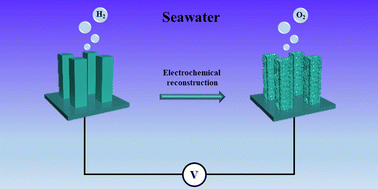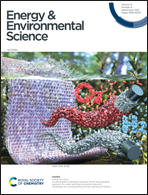Boosting efficient alkaline fresh water and seawater electrolysis via electrochemical reconstruction†
Abstract
Electrochemical reconstruction is a powerful tool for generating highly active oxygen evolution reaction (OER) catalysts. Utilizing electrochemical reconstruction to fabricate an OER active catalyst based on a hydrogen evolution reaction (HER) catalyst enables the development of a bifunctional catalyst that possesses state-of-the-art HER and OER activity simultaneously. Here we successfully synthesized Fe-doped Ni&Ni0.2Mo0.8N (Fe0.01-Ni&Ni0.2Mo0.8N) on Ni foam and, after rapid electrochemical reconstruction, the Fe-doped Ni&Ni0.2Mo0.8N compound was reconstructed into NiO co-doped with Fe and Mo (Fe0.01&Mo-NiO). The Fe0.01-Ni&Ni0.2Mo0.8N and Fe0.01&Mo-NiO compounds were found to exhibit state-of-the-art HER and OER performance, respectively. Alkaline fresh water/seawater electrolysis was then systematically studied using the two-electrode electrolyzer Fe0.01-Ni&Ni0.2Mo0.8N‖Fe0.01&Mo-NiO. Due to the excellent seawater HER and OER activity of the individual catalysts, the electrolyzer exhibited record-high performance for seawater electrolysis, achieving a current density of 688 mA cm−2 at 1.7 V. Further experiments under quasi-industrial conditions (6 M KOH & seawater, 60 °C) showed that the electrolyzer delivers a current density of 1000 mA cm−2 at the extremely low voltage of 1.562 V, which is only 1.49% higher than that required for fresh water under the same conditions. Stability testing of the electrolyzer showed that it exhibits good durability over 80 h under the harsh industrial conditions. Therefore, the findings in this research promote the development of bifunctional catalysts and address the small performance differences between alkaline fresh water and seawater electrolysis under industrial conditions.



 Please wait while we load your content...
Please wait while we load your content...